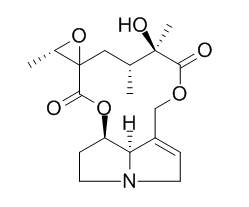Jacobine
Jacobine induces significant dose-dependent DNA-DNA interstrand cross-linking over the entire range of doses. It was catalyzed by guinea pig hepatic glutathione-S-transferase enzymes in in vitro experiments.
Inquire / Order:
manager@chemfaces.com
Technical Inquiries:
service@chemfaces.com
Tel:
+86-27-84237783
Fax:
+86-27-84254680
Address:
1 Building, No. 83, CheCheng Rd., Wuhan Economic and Technological Development Zone, Wuhan, Hubei 430056, PRC
Providing storage is as stated on the product vial and the vial is kept tightly sealed, the product can be stored for up to
24 months(2-8C).
Wherever possible, you should prepare and use solutions on the same day. However, if you need to make up stock solutions in advance, we recommend that you store the solution as aliquots in tightly sealed vials at -20C. Generally, these will be useable for up to two weeks. Before use, and prior to opening the vial we recommend that you allow your product to equilibrate to room temperature for at least 1 hour.
Need more advice on solubility, usage and handling? Please email to: service@chemfaces.com
The packaging of the product may have turned upside down during transportation, resulting in the natural compounds adhering to the neck or cap of the vial. take the vial out of its packaging and gently shake to let the compounds fall to the bottom of the vial. for liquid products, centrifuge at 200-500 RPM to gather the liquid at the bottom of the vial. try to avoid loss or contamination during handling.
Antioxidants (Basel).2021, 10(3):379.
Int J Mol Med.2020, 45(5):1514-1524.
Research Square2024, 4805471.
J Appl Toxicol.2024, jat.4615.
Tropical Journal of Pharmaceutical Research 2021, 20(6):1165-1170.
Dental Journal2024, 57(4): 254-258
Hortic Res.2023, 10(9):uhad154.
Antioxidants (Basel).2020, 9(6):466.
Phytochemistry Letters2017, 449-455
Malaysian Journal of Analytical Sciences2023, 27(4):840-848.
Related and Featured Products
Biochemical and Biophysical Research Communications,1994,198(2):516–522.
Glutathione Conjugation with the Pyrrolizidine Alkaloid, Jacobine[Reference:
WebLink]
METHODS AND RESULTS:
The reaction of glutathione with the epoxide containing pyrrolizidine alkaloid, Jacobine, was catalyzed by guinea pig hepatic glutathione-S-transferase enzymes in in vitro experiments; the rate of the reaction in the presence of rat hepatic glutathione-S-transferases did not differ from the non-enzymatic rate. Using ion-pairing liquid chromatography we were able to isolate the conjugate and obtain a daughter ion spectrum using Fast Atom Bombardment Mass Spectrometry together with Collisionally Activated Dissociation/Mass Analyzed Kinetic Energy experiments.
Toxicology Letters.1986,32(3):275-281.
Genotoxicity of the pyrrolizidine alkaloid jacobine in rats[Reference:
WebLink]
Jacobine (JAC) is a pyrolizidine alkaloid (PA) exhibiting adverse hepatic effects similar to those induced by another PA, monocrotaline (MCT). The in vitro reaction kinetics of JAC, however, have been reported to differ quantitively from those of MCT.
METHODS AND RESULTS:
We report results of experiments to detect and characterize hepatic DNA damage resulting from in vivo administration of JAC (5–60 mg/kg i.p.) to male Sprague-Dawley rats. Hepatic nuclei were isolated and served as the source of DNA in these experiments. Alkaline elution was employed to characterize the type(s) of DNA damage induced. At 4 h post administration, JAC induced significant dose-dependent DNA-DNA interstrand cross-linking over the entire range of doses. Significant DNA-protein cross-linking was also induced by doses of 15–60 mg/kg. No DNA single-strand breaks were detected. Previous studies in this laboratory have shown MCT to induce these same types of lesions.
CONCLUSIONS:
Results from these experiments demonstrate that despite a reported difference in in vitro reaction kinetics, these compounds induce a similar spectrum of DNA damage in the target organ of a susceptible species, where the adverse effects induced are also similar, such similarities are consistent with the involvement of DNA damage in the adverse hepatic effects of PAs.



